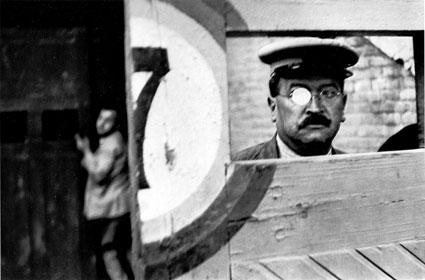HCB would have been 100 in 2008. For some reason his centenary is still being celebrated with two exhibitions which recently opened in Paris at the Maison Européene de la Photographie and today at the Musée d'Art Moderne (MAM). I was reminded of the Robert Frank exhibitions that were recently held in honour of the 50th anniversary of his seminal book, The Americans. I didn't see the exhibition at the NGA in Washington, Looking In, but judging by the catalogue this was a really impressive show in which the curators used this anniversary to take a fresh look at Frank's work for this series, uncovering new material and contributing a meaningful new perspective on the place of that series in photographic history. The exhibition that I saw at the Jeu de Paume was the polar opposite: it was essentially the book hung, in order, on the wall. There seemed to be no attempt to use this opportunity to do something different with the series, to uncover new details, present it in a new light, even develop a new scenography. As I walked around on the opening weekend with the hundreds of other people, waiting 2 or 3 minutes to see each image, this felt very much like an attempt to get as many people through the door with as little effort as possible.
Unfortunately, the current Cartier-Bresson mini-retrospective at the MAM, L'imaginaire d'après nature, falls into the latter category. The exhibition contains 69 large-format prints made in the 1970s, and donated to the museum in 1982 following two exhibitions of his photographs and drawings. This exhibition brings these donated prints out of storage after 27 years and I was curious to see what they would add to our understanding of HCB. Apparently one of the reasons why this is not "just another HCB exhibition" is that this is a unique opportunity to see appreciate his prints in a large format (they are around 50 x 70 cm, dry-mounted on board and unframed), and to "interact with the print as object", not just to appreciate the quality of his imagery in a small format behind a pane of glass. However, HCB didn't make the prints himself and I find that the images are not suited to these large formats. So maybe the value of the exhibition is in the choice of images, perhaps focusing on some lesser-known aspect of his work? The genius of HCB is indisputable, and many of these images still manage to retain their impact despite being so well-known, but while there are a handful of rarities, 95% of what is on show here has been seen everywhere and by everyone.
Seeing this exhibition at a National Museum of Modern Art in 1982 would have been a revelation and a bold statement on the place of photography within art. Seeing it today, it feels precisely like "just another Cartier-Bresson exhibition", and one which is attempting to cash in cheaply on an anniversary.
Rating: Worth looking elsewhere
